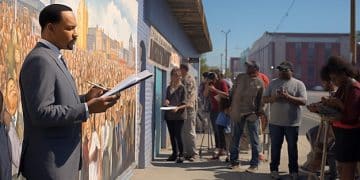Storytelling for social change: Turning personal truth into collective action

Storytelling for social change isn’t just about telling a good story, it’s about shifting perspectives, sparking emotion, and mobilizing action. Behind every powerful movement lies a narrative that made people care. That’s what stories do, they make us feel, and feeling leads to action.
In a world saturated with data, it’s the lived experiences that cut through the noise. Community voices bring heart to the headlines. And when they’re shared with honesty and purpose, they don’t just inform, they transform.
Let’s explore how storytelling channels the strength of authentic voices to build bridges, challenge injustice, and ignite lasting change.
The essence of community voices in storytelling
Community voices breathe life into causes. They’re the heartbeat behind movements, shaped by real experiences, not abstract theories. When people speak from their truth, the impact is immediate and personal.
Storytelling for social change thrives on this authenticity. Unlike data alone, it places a human face on complex issues, sparking empathy in ways numbers never could. A powerful story turns policy into people.
These narratives bridge gaps between lived reality and public awareness. They allow us to understand struggles that might otherwise feel distant, making the social more personal, and more urgent.
Why personal stories matter
There’s unmatched power in someone saying, “This happened to me.” Personal stories cut through apathy because they speak directly to the heart and the conscience.
Storytelling for social change works best when it centers lived experience. These narratives create intimacy between speaker and listener, transforming bystanders into allies.
When someone shares their reality, their fears, hopes, and obstacles, we lean in. That connection builds trust and reveals the human cost behind policies and systems, pushing us to act.
The impact of authenticity
Authenticity is magnetic. When stories feel real, unfiltered, and raw, they create immediate emotional resonance. That’s what drives engagement and loyalty in any movement.
Storytelling for social change is grounded in trust. People don’t just want polished content, they want sincerity. Real voices, real language, real emotion.
By staying true to the storyteller’s voice, we preserve dignity and ensure connection. Authentic storytelling invites reflection, promotes solidarity, and demands a response rooted in compassion.
Unveiling the transformative potential of storytelling
Storytelling for social change becomes transformational when it reveals hidden truths. It pulls back the curtain on injustice, creating space for empathy, healing, and collective growth.
Each story shared challenges the status quo. When people see themselves reflected in others’ experiences, barriers begin to crumble. That recognition opens the door to solidarity.
In this way, storytelling becomes more than communication, it’s activism. It teaches us to listen, to care, and to act, reimagining what’s possible for our communities.
Raising awareness
Not every problem makes headlines, but stories can change that. First-person narratives bring visibility to silent struggles, making the invisible seen.
Storytelling for social change puts neglected issues in the spotlight, giving them urgency and depth. It forces audiences to confront realities they might otherwise ignore.
Through story, awareness becomes impossible to ignore. Suddenly, statistics have names, histories, and voices, and with them, a demand for justice.
Breaking down stereotypes
A single story can upend years of bias. When people tell their truth, they often defy the stereotypes imposed on them.
Storytelling for social change invites complexity. It’s harder to label or dehumanize someone once you’ve heard their lived experience in their own words.
Personal stories expose the richness of identity and reveal that no one is just one thing. This understanding erodes prejudice and replaces it with respect.

Amplifying voices: Strategies for effective outreach
The true power of storytelling for social change lies in reach. Stories must not only be told, they must be heard by those who can be moved to respond.
To make an impact, stories need structure, support, and strategic sharing. Outreach must be inclusive, respectful, and tailored to each audience’s language and context.
When handled with care, storytelling can spark national conversations and influence policy. But it starts by listening, and lifting up, the voices that matter most.
Community partnerships
Local organizations know their people, and people trust them. Collaborating with these groups ensures stories are rooted in the community.
Storytelling for social change depends on trust. Through partnerships, storytellers feel safe to speak, and listeners feel confident enough to listen.
When institutions and grassroots leaders work together, the result is authentic, far-reaching storytelling that reflects lived truth, not outsider interpretation.
Digital platforms and social media
Online platforms are megaphones for marginalized voices. When used well, they turn a local story into a global conversation.
Storytelling for social change flourishes on social media where virality meets vulnerability. A post, a video, a podcast, each becomes a tool for awareness and mobilization.
Accessible formats like reels, threads, and lives remove barriers, letting more people engage, share, and act instantly, anytime, anywhere.
Overcoming challenges: Building trust and ensuring authenticity
To be inclusive, storytelling must meet people where they are. That means accessible language, formats, and platforms across age, literacy, and ability.
Storytelling for social change also thrives on connection. Strong networks expand reach, and a mosaic of storytellers enriches the narrative landscape.
By valuing diverse methods and perspectives, we build a storytelling ecosystem where every voice counts and every story has a place.
Addressing power dynamics
Power imbalances can distort or silence real stories. It’s crucial to center storytellers, not intermediaries or agendas.
Storytelling for social change respects autonomy. Support, not shape, the narrative. Empower people to tell their own stories in their own words.
This approach safeguards dignity and ensures that storytelling reflects lived experience, not institutional assumptions.
Protecting privacy and confidentiality
Storytellers deserve safety. That means knowing where their story goes, how it’s used, and who controls it.
Storytelling for social change demands informed consent and confidentiality. Sometimes names must change. Sometimes details must blur.
What matters is that the storyteller remains in charge, and protected every step of the way.
Measuring impact: Evaluating the success of storytelling initiatives
Not all impact is visible, but all impact matters. To understand how stories change minds and systems, we must measure their ripple effects.
Storytelling for social change needs both heart and data. Tracking awareness, engagement, and action helps refine strategies and amplify results.
Evaluation helps storytellers and organizers understand what’s working, what’s not, and what’s next.
Qualitative assessments
Interviews, feedback, and narrative analysis reveal emotional shifts and behavioral changes that stats can’t capture.
Storytelling for social change becomes clearer through real reflections, how people felt, what they learned, and what they did differently.
These insights show how deeply stories move us, and why they matter.
Quantitative metrics
Views, clicks, shares, and survey scores show reach and resonance. They tell us how far stories travel and how many people they touch.
Storytelling for social change benefits from tracking growth over time, helping teams see trends and expand impact strategically.
Numbers tell one story, emotions tell another. Together, they shape the full picture.
SMART Goals, Diverse Data, Real Analysis
Goals give direction. Data gives context. Analysis gives insight.
Storytelling for social change is strengthened when grounded in outcomes. What shifted? What conversations emerged? What policies changed?
By connecting emotion to evidence, storytelling becomes not just inspiring, but measurable and enduring.
Future trends: Innovations in community-driven narratives
The future of storytelling for social change is bold, tech-driven, and radically inclusive. Innovation is expanding how, where, and by whom stories are told.
As tools evolve, so does potential. Virtual spaces, AI-powered platforms, and interactive formats are transforming passive audiences into active participants.
The next chapter in storytelling will be co-created, boundary-pushing, and power-shifting.
Virtual Reality (VR) and immersive experiences
VR brings stories to life in ways that transcend words. It lets audiences walk in someone else’s world, even for a few minutes.
Storytelling for social change gains a new dimension with immersive empathy. You don’t just hear the story, you live it.
That level of engagement makes issues unforgettable, and harder to ignore.
Artificial Intelligence (AI) and personalized storytelling
AI can be used to personalize storytelling experiences, tailoring narratives to individual interests and preferences. This approach can increase engagement and ensure that stories resonate more deeply with audiences.
- Augmented Reality (AR): Augmented reality offers creative ways to integrate digital stories into physical spaces.
- Interactive Platforms: As technology evolves so to does the ease in which stories can be shared.
- Embracing Inclusivity: Community driven narratives allow for a range of voices to be heard and considered.
Storytelling that shifts the world
Storytelling for social change isn’t just about sharing stories, it’s about reshaping society. Every authentic voice adds to a chorus demanding better.
When personal truths are honored, when strategies elevate the unheard, and when innovation drives inclusion, storytelling becomes unstoppable.
It’s not just about being heard. It’s about being felt, and through that feeling, inspiring the world to move forward.
| Key Point | Brief Description |
|---|---|
| 🗣️ Authentic Voices | Highlighting genuine community narratives. |
| 🤝 Building Empathy | Fostering understanding through shared experiences. |
| 📢 Effective Outreach | Strategies to amplify diverse narratives. |
| 📈 Measuring Impact | Evaluating the success of social initiatives through storytelling. |
Frequently Asked Questions
▼
Personal stories promote social change by conveying personal experiences, challenging assumptions, and igniting empathy, which motivates individuals to act and fight for justness by sharing tales of triumph and tribulation.
▼
Key elements of effective storytelling include authenticity, clarity, emotional connection, and a compelling narrative structure. The narrative should inspire emotion and engage the audience, with the storyline being structured effectively.
▼
Communities can ensure their voices are heard by leveraging digital platforms, partnering with local organizations, engaging in public forums, and utilizing storytelling to share their personal experiences and promote change by telling tales.
▼
Ethical considerations in community storytelling include obtaining informed consent, protecting privacy, avoiding exploitation, and ensuring transparency. These practices maintain respect between the storyteller and the individual the story is about.
▼
Technology enhances community-driven narratives through virtual reality, AI, and augmented reality, by offering digital means for stories to connect with a large audience, and continue the legacy of oral traditions and shared experiences.





